International Business Strategy: A Case Study of Yamaha
Added on 2023-06-11
23 Pages5371 Words68 Views
Running head: INTERNATIONAL BUSINESS STRATEGY
INTERNATIONAL BUSINESS STRATEGY
Name of the Student
Name of the University
Author’s Note
INTERNATIONAL BUSINESS STRATEGY
Name of the Student
Name of the University
Author’s Note
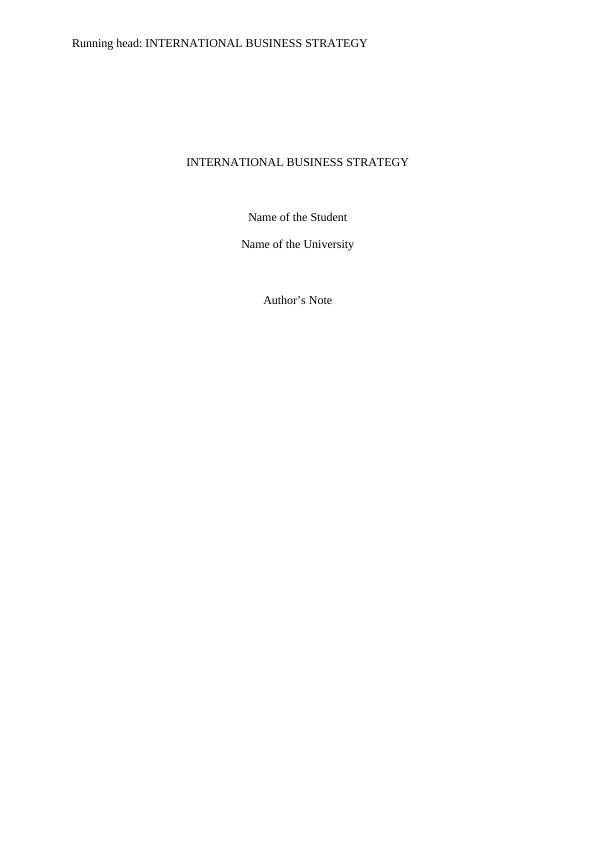
1INTERNATIONAL BUSINESS STRATEGY
Executive Summary
This report will discuss about the business strategy of Yamaha. Yamaha is a Japanese
multinational company, which has a huge product range. SWOT, PEST and Porter’s five
forces theory will be conducted to understand the factors that affect Yamaha. Ansoff matric
will also be used to help Yamaha find out how they can diversify their product, develop their
products, expand their market and how they can penetrate the market. Strategic plan will also
be discussed to know the problems that the organisation is facing and how it can be solved.
Executive Summary
This report will discuss about the business strategy of Yamaha. Yamaha is a Japanese
multinational company, which has a huge product range. SWOT, PEST and Porter’s five
forces theory will be conducted to understand the factors that affect Yamaha. Ansoff matric
will also be used to help Yamaha find out how they can diversify their product, develop their
products, expand their market and how they can penetrate the market. Strategic plan will also
be discussed to know the problems that the organisation is facing and how it can be solved.
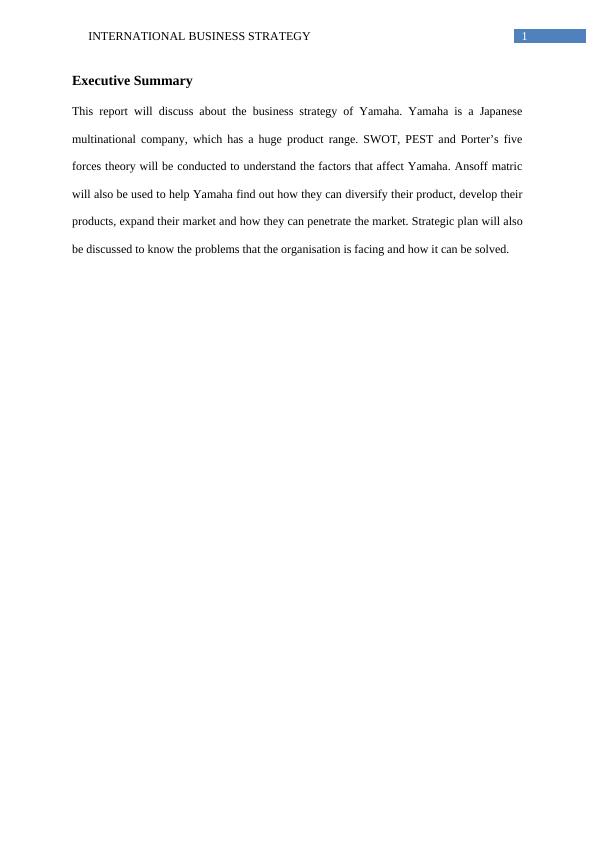
2INTERNATIONAL BUSINESS STRATEGY
Table of Contents
Introduction:...............................................................................................................................3
Discussion:.................................................................................................................................4
Company Overview...............................................................................................................4
Key products:.....................................................................................................................5
SWOT analysis of Yamaha................................................................................................5
PEST analysis:...................................................................................................................8
Porter’s five forces theory:.................................................................................................9
Ansoff model:.......................................................................................................................11
Communicating with the stakeholders.............................................................................13
Resources:........................................................................................................................13
Strategic Plan Development.................................................................................................14
Yamaha’s excellence............................................................................................................15
Conclusion:..............................................................................................................................16
References:...............................................................................................................................17
Table of Contents
Introduction:...............................................................................................................................3
Discussion:.................................................................................................................................4
Company Overview...............................................................................................................4
Key products:.....................................................................................................................5
SWOT analysis of Yamaha................................................................................................5
PEST analysis:...................................................................................................................8
Porter’s five forces theory:.................................................................................................9
Ansoff model:.......................................................................................................................11
Communicating with the stakeholders.............................................................................13
Resources:........................................................................................................................13
Strategic Plan Development.................................................................................................14
Yamaha’s excellence............................................................................................................15
Conclusion:..............................................................................................................................16
References:...............................................................................................................................17
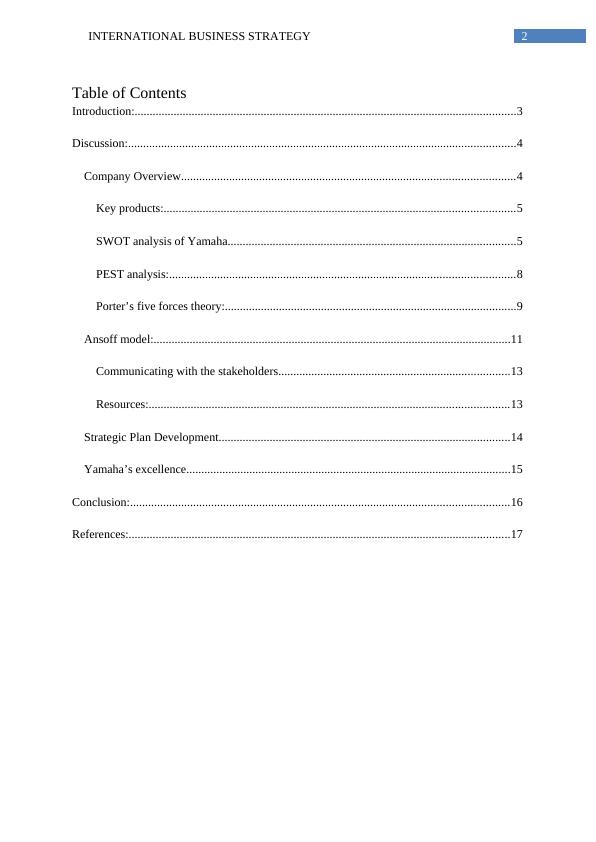
3INTERNATIONAL BUSINESS STRATEGY
Introduction:
This assignment will discuss about the SAFe criteria. SAFe is the acronym for
Suitability, Acceptability and Feasibility. Under suitability SWOT, PEST and Porter’s five
forces theory will be conducted to understand the key external and internal factor that affects
the organisation. Yamaha has been selected as the organisation to understand its key external
and internal factors, Strengths and weaknesses that the organisation is having and the
opportunities and threats that the organisation may face or is facing recently. Ansoff matrix
has also been discussed in this report to provide some strategy how it can help Yamaha in
expanding the business. The Ansoff model will discuss about product development, market
penetration, market development and product diversification. Yamaha is a reputed company
with a huge market share and is loved by all for its excellent quality and service they provide.
Yamaha has a number of products starting from musical instrument to electronics but the
most profitable sector of Yamaha is the motorcycle division. They have a huge brand
goodwill in the market and a good customer base but in recent years, they have suffered
reduced sales and many other issues, which are discussed in this assignment. This report will
discuss about the problems and will provide some recommendation how the problems can be
minimised (Yamaha.com, 2018).
Introduction:
This assignment will discuss about the SAFe criteria. SAFe is the acronym for
Suitability, Acceptability and Feasibility. Under suitability SWOT, PEST and Porter’s five
forces theory will be conducted to understand the key external and internal factor that affects
the organisation. Yamaha has been selected as the organisation to understand its key external
and internal factors, Strengths and weaknesses that the organisation is having and the
opportunities and threats that the organisation may face or is facing recently. Ansoff matrix
has also been discussed in this report to provide some strategy how it can help Yamaha in
expanding the business. The Ansoff model will discuss about product development, market
penetration, market development and product diversification. Yamaha is a reputed company
with a huge market share and is loved by all for its excellent quality and service they provide.
Yamaha has a number of products starting from musical instrument to electronics but the
most profitable sector of Yamaha is the motorcycle division. They have a huge brand
goodwill in the market and a good customer base but in recent years, they have suffered
reduced sales and many other issues, which are discussed in this assignment. This report will
discuss about the problems and will provide some recommendation how the problems can be
minimised (Yamaha.com, 2018).

4INTERNATIONAL BUSINESS STRATEGY
Discussion:
SAFe is the acronym for Suitability, Acceptability and Feasibility. Jerry Johnson
developed this model to analyse the business strategy and the organisation. Under suitability
SWOT analysis, PEST analysis, Porter’s five forces theory and the value chain analysis are
conducted to understand the internal and the external factors that affect the working of the
organisation. The acceptability factor examines whether the strategy meets the stakeholders
expectations, the risk level, which the organisation is taking, is acceptable, the return on
investment is suitable for the organisation or not. Feasibility helps to understand whether the
organisation will work in the environment, how the organisation can be financed, availability
of skilled labours or how the skilled labour can be achieved and how the resources can be
obtained for the organisation. In the assignment, we will use PESTEL, Porter’s 5 forces
theory, value chain analysis and the SWOT analysis for examining the suitability of the
organisation (Johnson 2016). Ansoff model will examine the acceptability of the current
strategy by the stakeholders. In the assignment, Yamaha is chosen to understand to examine
their business strategy (Team 2013).
Company Overview
Yamaha is a Japanese conglomerate and multinational company, which deals with a
various range of products starting from musical instrument to electronics (Khan, Jain and
Sharma 2013). Yamaha is also a largest producer of consumer vehicles like superbikes but
the motorcycle division got separated from the main company in 1955 and formed Yamaha
Motors. Torakusu Yamaha founded Yamaha Corporation in October 12, 1887. The
headquarters of Yamaha is located in Shizuoka, Japan. The organisation earned revenue of
408.2 billion JPY in the year 2017. The operation income of the company is accounted 44.3
billion JPY at the end of 2017. Yamaha had a net income of 46.7 billion JPY in 2017. The
Discussion:
SAFe is the acronym for Suitability, Acceptability and Feasibility. Jerry Johnson
developed this model to analyse the business strategy and the organisation. Under suitability
SWOT analysis, PEST analysis, Porter’s five forces theory and the value chain analysis are
conducted to understand the internal and the external factors that affect the working of the
organisation. The acceptability factor examines whether the strategy meets the stakeholders
expectations, the risk level, which the organisation is taking, is acceptable, the return on
investment is suitable for the organisation or not. Feasibility helps to understand whether the
organisation will work in the environment, how the organisation can be financed, availability
of skilled labours or how the skilled labour can be achieved and how the resources can be
obtained for the organisation. In the assignment, we will use PESTEL, Porter’s 5 forces
theory, value chain analysis and the SWOT analysis for examining the suitability of the
organisation (Johnson 2016). Ansoff model will examine the acceptability of the current
strategy by the stakeholders. In the assignment, Yamaha is chosen to understand to examine
their business strategy (Team 2013).
Company Overview
Yamaha is a Japanese conglomerate and multinational company, which deals with a
various range of products starting from musical instrument to electronics (Khan, Jain and
Sharma 2013). Yamaha is also a largest producer of consumer vehicles like superbikes but
the motorcycle division got separated from the main company in 1955 and formed Yamaha
Motors. Torakusu Yamaha founded Yamaha Corporation in October 12, 1887. The
headquarters of Yamaha is located in Shizuoka, Japan. The organisation earned revenue of
408.2 billion JPY in the year 2017. The operation income of the company is accounted 44.3
billion JPY at the end of 2017. Yamaha had a net income of 46.7 billion JPY in 2017. The
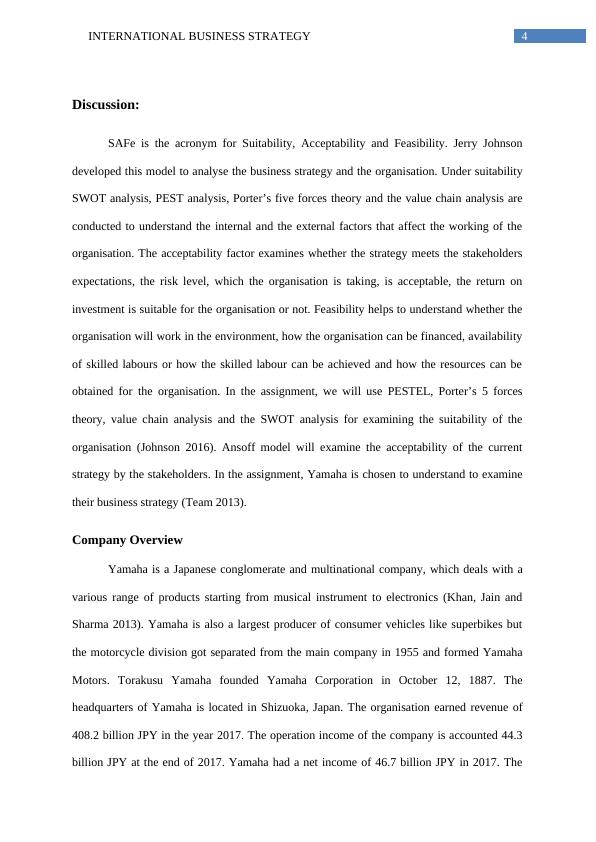
5INTERNATIONAL BUSINESS STRATEGY
organisation employs 28,112 employees worldwide, which includes temporary employees
(Yamaha.com, 2018). Yamaha is the largest manufacturing brand of piano in the world.
Key products:
Yamaha has a wide range of products and some of its key products are listed below:
Musical instruments such as piano, guitars
Audio equipment’s such as speakers, music systems
Electronics product
Under its subsidiary company, Yamaha Motor Co. Ltd produces the following
products:
Motorcycles
All-terrain vehicles
Marine engines
Wheelchairs
Personal Watercraft
SWOT analysis of Yamaha
SWOT analysis will help us to understand the strength, weakness, opportunities and
threats that the organisation is facing or might face in the future. SWOT analysis examines
the internal and the external factors (Wang and Ge 2013).
Strengths:
Yamaha Corporation has excellent brand value. The advertising of the Yamaha
products is one of the key factors, which led them to huge popularity and brand
awareness among the customer (Iglesias, Ind and Alfaro 2013). The distribution
channel of Yamaha is better than many of his rivals, which has let them to expand
their business worldwide and maintain a good customer base.
organisation employs 28,112 employees worldwide, which includes temporary employees
(Yamaha.com, 2018). Yamaha is the largest manufacturing brand of piano in the world.
Key products:
Yamaha has a wide range of products and some of its key products are listed below:
Musical instruments such as piano, guitars
Audio equipment’s such as speakers, music systems
Electronics product
Under its subsidiary company, Yamaha Motor Co. Ltd produces the following
products:
Motorcycles
All-terrain vehicles
Marine engines
Wheelchairs
Personal Watercraft
SWOT analysis of Yamaha
SWOT analysis will help us to understand the strength, weakness, opportunities and
threats that the organisation is facing or might face in the future. SWOT analysis examines
the internal and the external factors (Wang and Ge 2013).
Strengths:
Yamaha Corporation has excellent brand value. The advertising of the Yamaha
products is one of the key factors, which led them to huge popularity and brand
awareness among the customer (Iglesias, Ind and Alfaro 2013). The distribution
channel of Yamaha is better than many of his rivals, which has let them to expand
their business worldwide and maintain a good customer base.
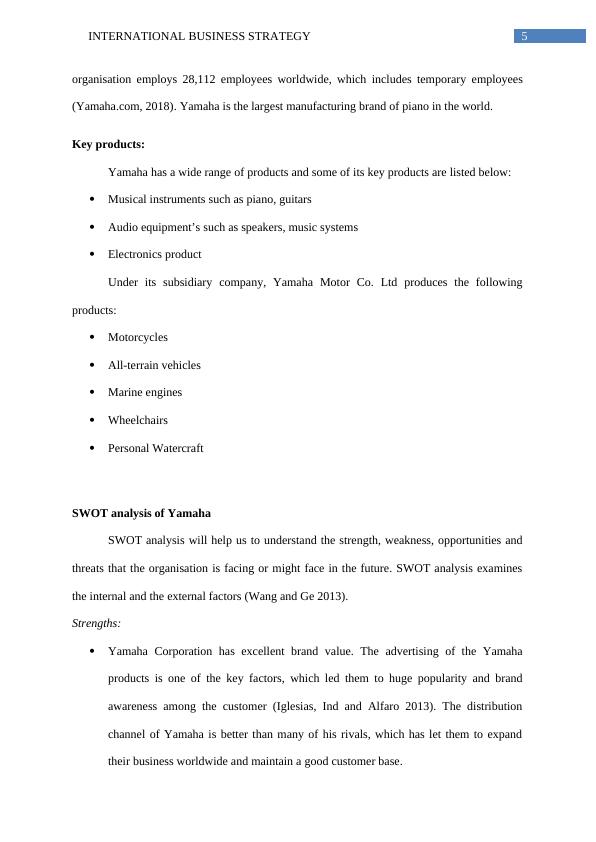
End of preview
Want to access all the pages? Upload your documents or become a member.
Related Documents
Strategic Hospitality Management: Analysis of Cadbury UK's SWOT, VRIO, PEST, Porter's Five Forces, Stakeholder Mapping, and Future Strategylg...
|24
|760
|236
SWOT Analysis Assignment | PESTEL Analysislg...
|8
|639
|37
Assignment - Strategic Managementlg...
|19
|3562
|17
Strategic Models: Porter’s Five Forces, Ansoff Matrix, VRIN, SWOT Analysislg...
|12
|1469
|54
Competitive Studies: SWOT, Five Forces and Porter’s Generic Frameworklg...
|8
|2171
|482
Business Strategy Assignment : Zara organisationlg...
|12
|3890
|238
